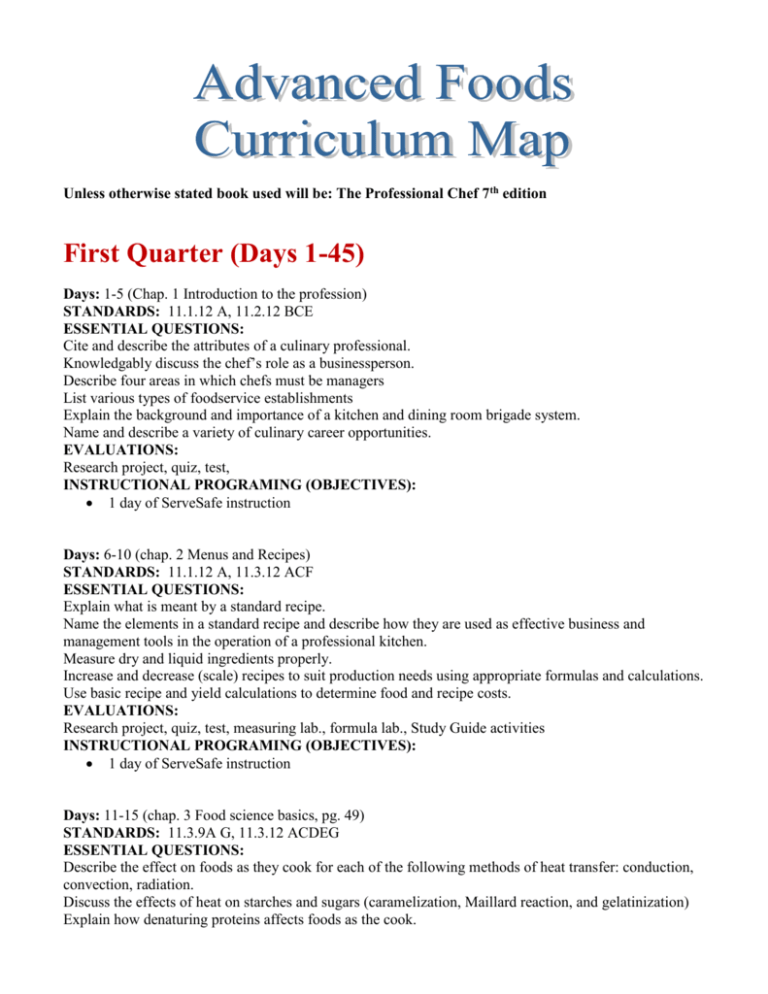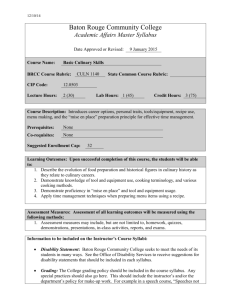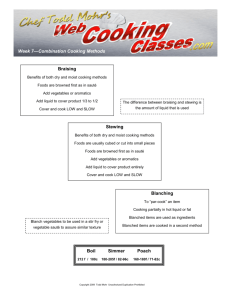Advanced Foods Curriculum Mapping 1-16-12
advertisement

Unless otherwise stated book used will be: The Professional Chef 7th edition First Quarter (Days 1-45) Days: 1-5 (Chap. 1 Introduction to the profession) STANDARDS: 11.1.12 A, 11.2.12 BCE ESSENTIAL QUESTIONS: Cite and describe the attributes of a culinary professional. Knowledgably discuss the chef’s role as a businessperson. Describe four areas in which chefs must be managers List various types of foodservice establishments Explain the background and importance of a kitchen and dining room brigade system. Name and describe a variety of culinary career opportunities. EVALUATIONS: Research project, quiz, test, INSTRUCTIONAL PROGRAMING (OBJECTIVES): 1 day of ServeSafe instruction Days: 6-10 (chap. 2 Menus and Recipes) STANDARDS: 11.1.12 A, 11.3.12 ACF ESSENTIAL QUESTIONS: Explain what is meant by a standard recipe. Name the elements in a standard recipe and describe how they are used as effective business and management tools in the operation of a professional kitchen. Measure dry and liquid ingredients properly. Increase and decrease (scale) recipes to suit production needs using appropriate formulas and calculations. Use basic recipe and yield calculations to determine food and recipe costs. EVALUATIONS: Research project, quiz, test, measuring lab., formula lab., Study Guide activities INSTRUCTIONAL PROGRAMING (OBJECTIVES): 1 day of ServeSafe instruction Days: 11-15 (chap. 3 Food science basics, pg. 49) STANDARDS: 11.3.9A G, 11.3.12 ACDEG ESSENTIAL QUESTIONS: Describe the effect on foods as they cook for each of the following methods of heat transfer: conduction, convection, radiation. Discuss the effects of heat on starches and sugars (caramelization, Maillard reaction, and gelatinization) Explain how denaturing proteins affects foods as the cook. Describe the functions of cooking fats. Name the types of emulsions and describe how they are formed. EVALUATIONS: quiz, test, cooking lab., Study Guide activities INSTRUCTIONAL PROGRAMING (OBJECTIVES): 1 day of ServeSafe instruction Days: 16-25 (chap. 4 Food and kitchen safety) STANDARDS: 11.3.3 B, 11.3.6BF, 11.3.9B, 11.3.12 B ESSENTIAL QUESTIONS: Explain what is meant by adulterated foods and the ways in which foods become adulterated. Name the types of pathogens responsible for food-borne illness, and describe how they affect foods as well as how they reproduce in foods. Name and explain the three conditions for pathogen growth in potentially hazardous foods List and use several techniques to avoid cross contamination Explain the importance of proper hand washing Show and explain how to keep foods out of the danger zone. Explain what is meant by kitchen safety and list several guidelines and techniques for maintain safety in the kitchen and dining room. Identify the appropriate regulations, inspections, and certifications required of foodservice personnel. EVALUATIONS: quiz, test, cooking lab., Study Guide activities, research project INSTRUCTIONAL PROGRAMING (OBJECTIVES): 2 days of ServeSafe instruction Days: 26-30 (chap. 5 Equipment Identification) STANDARDS: 11.2.9 E, 11.3.6 BF ESSENTIAL QUESTIONS: Identify the basic parts of a knife Identify a variety of knives and use them properly Name a variety of hand tools, describe their function, and select and use these tools properly to complete a specific task. Name a variety of small equipment, including measuring equipment, sieves and strainers Identify large equipment used to grind, slice, mix,and puree foods. EVALUATIONS: quiz, test, cutting lab., Study Guide activities, equipment identification lab. INSTRUCTIONAL PROGRAMING (OBJECTIVES): 1 day of ServeSafe instruction Days: 31-51 (chapters 11-14) Stocks, Sauces, and Soups STANDARDS: 11.3.3 G, 11.3.6 G, 11.3.9 G, 11.3.12 F ESSENTIAL QUESTIONS: Stocks: Define and use bouquet garni,and sachet d’epices, listing common ingredients for each and standard cooking times for flavor extraction. Prepare mirepoix and be able to describe common ingredients and several mirepoix variations. Explain the uses for roux and name the basic colors of roux. Combine roux and liquids properly according to temperature. Prepare clarified butter and describe its appropriate or common uses. Identify a variety of pure starches and their characteristics, use them to prepare a slurry, and substitute starches of different thickening powers in recipes using a standard formula. Sauces: Describe the characteristics and quality indicators for brown sauce, white sacue, tomato sauce, hollandaise and beurre blance. Describe the correct method for producing various sauces. Prepare, hold, and reheat sauces for the best flavor, texture, and color. Select sauces that are appropriate for specific foods, cooking techniques, or serving situations. Soups: Understand how to properly cook, finish, garnish, reheat, adjust consistency, and degrease clear and thick soups. Prepare and evaluate the quality of clear soups, including consommés, broths, and hearty broths. Prepare and evaluate the quality of thick soups, including purees, cream soups, chowders, and biques. Understand general guidelines for working with soups. Serve hot and cold soups in the correct manner. EVALUATIONS: quiz, test, cooking labs., Study Guide activities, teacher luncheon, recipe book check INSTRUCTIONAL PROGRAMING (OBJECTIVES): 4 days of ServeSafe instruction Second Quarter (Days 46-90) Days: 52- 66(chap.15&16) Mis en Place for Meats, Poultry, and Fish & Fabricating Meats, Poultry, and Fish STANDARDS: 11.1.12 B, 11.3.12 FG ESSENTIAL QUESTIONS: Mis en Place for Meats, Poultry, and Fish: Understand how and when salt, pepper, and other seasonings ingredients are applied to foods to achieve the desired purposes. Explain how spice blends, dry rubs, and wet marinades are composed and used. Discuss the role of stuffings and describe various types of stuffings Describe the use the standard breading procedure appropriately and safely Describe the test for doneness and how each is applied List the degree of doneness and final resting temperature for a range of items Fabricating Meats, Poultry, and Fish: Trim fat and silverskin from meats and explain the reason for doing so. Cut meats into even portions and shape them so that they will cook evenly Tie a roast Fabricate poultry Truss poultry for roasting or poaching Clean and devein shrimp EVALUATIONS: quiz, test, Fabrication labs., Study Guide activities, research project and/or power point demonstration INSTRUCTIONAL PROGRAMING (OBJECTIVES): 3 days of ServeSafe instruction Days: 67- 81(chap.17&18) Grilling and Broiling, Roasting and Baking & Sauteing, Pan Frying, and Deep Frying STANDARDS: 11.3.9 G, 11.3.12 B ESSENTIAL QUESTIONS: Select and prepare ingredients for grilling, broiling, roasting and baking Select and prepare equipment for grilling, broiling, roasting and baking Explain what is meant by a “zone” on a grill or broiler and how it can be used to adapt to different foods or different production needs Clean, preheat, and lubricate a grill and/or broiler Grill or broil meats, poultry, and fish to the correct doneness to develop the best flavor and texture on the finished dish. Describe roasting, baking, smoke roasting, rotisserie cooking, and spit-roasting Roast or bake meats, poultry, and fish to the correct doneness to develop the best favor and texture in the finished dish Carve roasts into portions. Select and prepare appropriate meats, poultry, or fish for sautéing, pan frying, an deep frying Saute, pan fry, and deep fry a variety of foods using the basic methods outlined in the text Use a safe technique for adding foods to be pan fried to the hot oil in the pan Describe the swimming and basket method for deep frying Determine doneness and evaluate quality in sautéed, pan fried and deep-fried foods EVALUATIONS: quiz, test, cooking labs., Study Guide activities, teacher luncheons, recipe books INSTRUCTIONAL PROGRAMING (OBJECTIVES): 3 days of ServeSafe instruction Days: 82- 90 (chap.19&20) Steaming and Submersion Cooking & Braising and Stewing STANDARDS: 11.3.9 G, 11.3.12 B ESSENTIAL QUESTIONS: Name and describe each of the following moist heat techniques – steaming, cooking foods en papillote, shallow poaching, deep poaching, and simmering Select and prepare meats, fish, or poultry for each method discussed Properly regulate cooking temperatures and determine doneness accurately for each method Evaluate the quality of foods prepared by these methods Name the similarities and differences between braising and stewing Prepare a braise or a stew using the basic method Name a variety of thickening options for stews and braises Evaluate the quality of stews and braises EVALUATIONS: quiz, test, cooking labs., Study Guide activities, teacher luncheons, recipe books INSTRUCTIONAL PROGRAMING (OBJECTIVES): 1 day of ServeSafe instruction Third Quarter (Days 91-135) Days: 91- 105 (chap.9&26) Dairy and Egg Purchasing and Identification & Cooking Eggs STANDARDS: 11.3.12 BF ESSENTIAL QUESTIONS: List the general guideline for purchasing and storing dairy and eggs Explain what is meant by pasteurization and homogenization of liquid dairy Identify the parts of an egg and list several uses and functions for whole eggs, egg yolks, and egg whites Name the grades, sizes, and processed forms of eggs Select and prepare eggs (and other ingredients as required) and equipment for specific egg preparations Cook eggs in the shell to a range of doneness and evaluate the quality of eggs cooked in the shell Poach eggs properly and hold them for service Fry eggs to a variety of doneness and evaluate their quality according to the appropriate standards Scramble eggs properly and name the characteristics of properly scrambled eggs Identify the different styles of omelet and describe the methods for each style and their quality characteristics Make a savory soufflé that rises properly and has a light texture. EVALUATIONS: quiz, test, cooking labs., Study Guide activities, recipe books, research project and/or power point presentation. INSTRUCTIONAL PROGRAMING (OBJECTIVES): 2 days of ServeSafe instruction Days: 106- 112 (chap.26) Cooking Eggs Teacher Luncheon STANDARDS: 11.3.12 BF ESSENTIAL QUESTIONS: Proper time management, equipment selection, ingredient selection handling and storage. Service etiquette EVALUATIONS: cooking labs., teacher luncheons, recipe books, time management sheet, market orders, costing sheets INSTRUCTIONAL PROGRAMING (OBJECTIVES): Days: 113- 119 (chap.27) Salad Dressings and Salads STANDARDS: 11.3.12 BFG ESSENTIAL QUESTIONS: Use the basic ratios and methods to prepare vinaigrettes and mayonnaise Describe how to rescue a broken mayonnaise Evaluate the quality of salad dressings according to the correct quality standards Name the purposes for a green salad Select and combine salad green and wash, dry, and store them properly Prepare flavored oils and vinegars and store them properly Select and prepare a variety of fresh fruits for salads Select and Prepare ingredients and dressings for warm, vegetable, potato, pasta grain, legume, and composed salad EVALUATIONS: quiz, test, cooking labs., Study Guide activities, recipe books, INSTRUCTIONAL PROGRAMING (OBJECTIVES): 1 day of ServeSafe instruction Days: 120- 124 (chap.27) Salad Dressings and Salads Teacher Luncheon STANDARDS: 11.3.12 BFG ESSENTIAL QUESTIONS: Proper time management, equipment selection, ingredient selection handling and storage. Service etiquette EVALUATIONS: cooking labs., teacher luncheons, recipe books, time management sheet, market orders, costing sheets INSTRUCTIONAL PROGRAMING (OBJECTIVES): Days: 125- 135 (chap.28) Sandwiches STANDARDS: 11.3.9 G, 11.3.12 F ESSENTIAL QUESTIONS: Name the basic components of a sandwich and describe the function of each component in the finished sandwich. Describe some of the ways that sandwiches can be presented Select sandwich shapes to maximize yield and lower food cost Organize your work station to prepare and serve sandwiches for maximum productivity and efficiency. EVALUATIONS: quiz, test, cooking labs., Study Guide activities, recipe books, Commercial Sandwich Production research project INSTRUCTIONAL PROGRAMING (OBJECTIVES): 2 days of ServeSafe instruction Fourth Quarter (Days 136-180) Days: 136- 140 (chap.28) Sandwich Competition STANDARDS: 11.3.9 G, 11.3.12 F ESSENTIAL QUESTIONS: Name the basic components of your sandwich and describe the function of each component in the finished sandwich. Describe some of the ways that your sandwich will be presented Select sandwich shapes to maximize yield and lower food cost Organize your work station to prepare and serve sandwich for maximum productivity and efficiency. EVALUATIONS: Sandwich Competition with teacher volunteers as judges INSTRUCTIONAL PROGRAMING (OBJECTIVES): Days: 141- 156 (chap.29) Hors-d’Oeuvre and Appetizers STANDARDS: 11.3.9 FG, 11.3.12 FG ESSENTIAL QUESTIONS: Distinguish between Hors-d’Oeuvre and Appetizers. Application for Cold Savory Mousse. Basic Guidelines for preparing and presenting appetizers. How to properly present (plating) Hors-d’Oeuvre and Appetizers. EVALUATIONS: Recipe book check, written test, workbook pages, Lab. trials INSTRUCTIONAL PROGRAMING (OBJECTIVES): 3 days of ServeSafe instruction Select and prepare ingredients, preparations, and garnishes for Hors-d’Oeuvre, Appetizers, and cold savory mousses.




